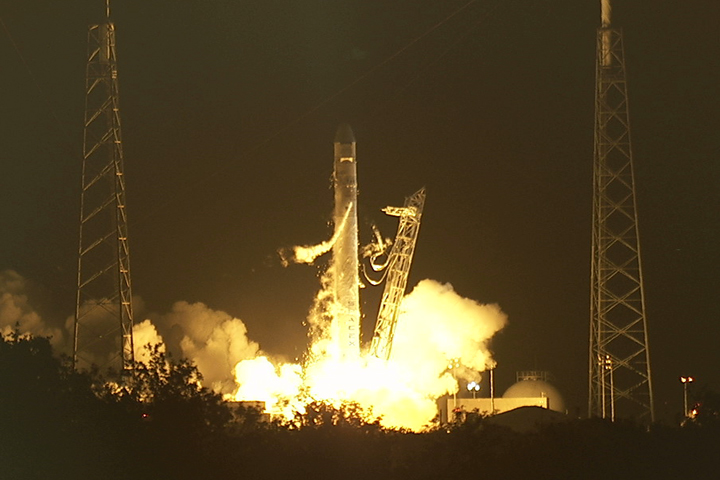Rocket exhaust pollution in the upper atmosphere might affect Earth's climate

A new study reveals how air pollution from rocket launches spreads in the atmosphere, potentially triggering dangerous warming at the otherwise pristine high altitudes.
A team of researchers at the University of Nicosia in Cyprus investigated how air pollution including carbon dioxide and soot spreads in the air as a rocket ascends through Earth's atmosphere.
The researchers found that concentrations of several pollutants in the mesosphere (the layer of the atmosphere at altitudes between 30 and 50 miles (50 and 80 kilometers)) remain disturbingly high for extended periods of time after each launch. These pollutants include the main climate-warming gas carbon dioxide, and that worries the scientists as local warming of higher layers of the atmosphere could have far reaching consequences for Earth's climate.
The researchers based their study on emissions generated by one of the most popular rockets of today, SpaceX's Falcon 9, which burns fossil-based rocket fuel RP1 and liquid oxygen. Such rockets generate exhaust that contains carbon dioxide and water vapor, as well as varying amounts of soot, nitrous oxides, and sulfur. Carbon dioxide, water vapor, and nitrous oxides are all greenhouse gases that absorb heat and warm our planet.
Related: The environmental impact of rocket launches: The 'dirty' and the 'green'
The team said in a statement that according to their simulations, the passage of a rocket through the mesosphere triggers a significant local and momentary increase in concentrations of carbon dioxide.
"The emitted mass of carbon dioxide as the rocket climbs 1 kilometer [0.6 miles] in altitude in the mesosphere is equivalent to that contained in 26 cubic kilometers [6.2 cubic miles] of atmospheric air at the same altitude," the researchers said in the statement, adding that such concentrations are, indeed, significant.
Get the Space.com Newsletter
Breaking space news, the latest updates on rocket launches, skywatching events and more!
Eventually, the circulation of the atmosphere dissipates those greenhouse gases and brings the concentrations back to "standard" levels. It is, however, unknown how long the concentrations remain elevated and what their impact on the temperature of the mesosphere could be.
Other types of impacts of rocket launches on the mesosphere have been described before. For example, launches of NASA's space shuttles were known to trigger the formation of spectacular polar mesospheric clouds, the highest-occurring type of clouds known to form in Earth's atmosphere. Scientists are also concerned about the impact of aluminum oxide and other particles present in rocket exhaust on stratospheric ozone and the thermal balance of Earth's atmosphere.
When it comes to greenhouse gasses alone, the contribution of rocket launches is rather negligible, accounting for only 1% of aviation's carbon footprint — which in itself only amounts to 2.4% of annual global carbon emissions, according to the Environmental and Energy Study Institute.
But the spaceflight industry is growing, with the number of launches scaling up each year. While the effects of rocket pollution on the atmosphere are currently not well studied, the results of this research suggest it might be a good idea to keep a close eye on the situation.
"We hope that commercial flight companies, such as SpaceX, Virgin Galactic, and the New Shepard, and their associated engine manufacturers, will consider these effects in future designs," the study's co-author Dimitris Drikakis, a multidisciplinary science professor at the University of Nicosia, Cyprus, said in the statement.
And they are. Both SpaceX and Blue Origin, the company that built the New Shephard rocket, are using methane-based fuel in their next-generation rockets (Starship and New Glenn, respectively). Current research indicates that methane-based fuel is extremely efficient at burning off during combustion, resulting in very few emissions beyond carbon dioxide, water vapor, and a trace of nitrous oxides, according to the Database of Emissions Indices published by National Academies.
The research was published on May 17 in Physics of Fluids.
Editor's note: This story was updated to clarify the methane-based fuels being used by certain rockets. Follow Stefanie Waldek on Twitter @StefanieWaldek. Follow us on Twitter @Spacedotcom and on Facebook.
Join our Space Forums to keep talking space on the latest missions, night sky and more! And if you have a news tip, correction or comment, let us know at: community@space.com.

Space.com contributing writer Stefanie Waldek is a self-taught space nerd and aviation geek who is passionate about all things spaceflight and astronomy. With a background in travel and design journalism, as well as a Bachelor of Arts degree from New York University, she specializes in the budding space tourism industry and Earth-based astrotourism. In her free time, you can find her watching rocket launches or looking up at the stars, wondering what is out there. Learn more about her work at www.stefaniewaldek.com.









